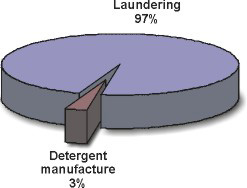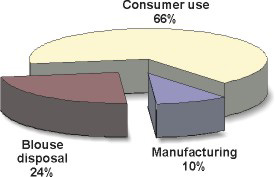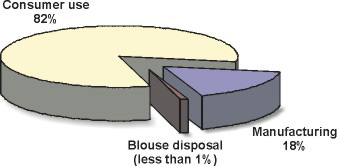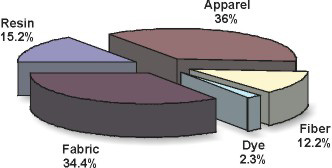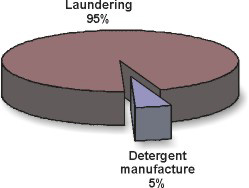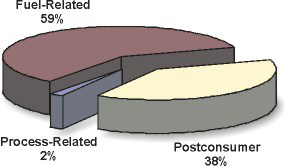Resource and Environmental Profile Analysis of a Manufacturerd Apparel Product
Life Cycle Analysis (LCA):
Woman's Knit Polyester Blouse
Final Report
Prepared
for American Fiber Manufacturers Association by Franklin
Associates, LTD (June 1993)
Table of Contents
EXECUTIVE SUMMARY
INTRODUCTION
RESEARCH PURPOSE
RESULTS AND DISCUSSION
Energy Requirements
Environmental Emissions
Solid Wastes
Atmospheric and Waterborne Emissions
Chapter 1 - STUDY APPROACH AND METHODOLOGY
INTRODUCTION
PURPOSE
METHODOLOGY
PRODUCT EXAMINED
DATA SOURCES
DATA GATHERING
Resin Manufacture
Fiber Manufacture
Fabric Manufacture
Dye Manufacture
Apparel Manufacture
Consumer Use (laundry)
Disposal OptionsRELIABILITY OF RESULTS
ENERGY REQUIREMENTS
ENVIRONMENTAL EMISSIONS
Atmospheric Emissions
Waterborne Wastes
Solid WastesGENERAL DECISIONS
Data Sources
Geographic Scope
Precombustion Energy and Emissions
Electricity
Postconsumer Waste Combustion
Reuse and Recycling
System Components Not Included
Capital Equipment
Space Conditioning
Support Personnel Requirements
Miscellaneous Materials and Additives
Chapter 2 - ENERGY AND ENVIRONMENTAL RESULTS
INTRODUCTION
SYSTEM DESCRIPTION
RESULTS AND DISCUSSION
Energy Requirements
Total Requirements
Categories of Energy
Energy Sources
Solid Waste
Atmospheric Emissions and Waterborne Wastes
Summary of Results for Manufacturing One Polyester Blouse
Chapter 3 - SENSITIVITY ANALYSIS OF LAUNDERY OPERATIONS
OVERVIEW
BASELINE LAUNDERING DATA
LAUNDERING SENSITIVITY ANALYSES
Wash Temperature
Machine Dryer Use
List of Tables
| 1-1 | Process Steps to be Examined | |
| 2-1 | Weight of One Woman's Knit Polyester Blouse and Packaging | |
| 2-2 | Total and Net Energy Requirements for 1,000,000 Wearings of Polyester Blouses | |
| 2-3 | Energy Requirements for 1,000,000 Wearings of Polyester Blouses | |
| 2-4 | Energy Profile for 1,000,000 Wearings of Polyester Blouses | |
| 2-5 | Solid Wastes for 1,000,000 Wearings of Polyester Blouses | |
| 2-6 | Summary of Environmental Emissions for 1,000,000 Wearings of Polyester Blouses | |
| 2-7 | Environmental Emissions by Component for 1,000,000 Wearings of Polyester Blouses | |
| 2-8 | Energy Requirements for the Manufacture of One Polyester Blouse | |
| 2-9 | Solid Wastes for the Manufacture of One Polyester Blouse | |
| 2-10 | Environmental Emissions by Component for the Manufacture of One Polyester Blouse | |
| 3-1 | Data For One Laundry Load | |
| 3-2 | Energy Requirements For Various Sensitivity Analyses |
List of Figures
| ES-1 | Summary of total energy requirements per million wearings | |
| ES-2 | Allocation of manufacturing energy requirements | |
| ES-3 | Allocation of consumer use energy requirements | |
| ES-4 | Summary of total solid wastes per million wearings | |
| ES-5 | Allocation of manufacturing created solid wastes | |
| ES-6 | Allocation of consumer use solid wastes | |
| ES-7 | Allocation of solid waste by type | |
| 1-1 | General materials flow for “cradle-to-grave” analysis of a product system | |
| 1-2 | Flow diagrams illustrating coproduct allocation for product 'A' | |
| 1-3 | Flow diagram for the manufacture, consumer use, and disposal of a woman's knit polyester blouse |
List of Acronyms and Abbreviations
| AFMA | American Fiber Manufactures Association | |
| BOD | Biological oxygen demand | |
| Btu | British thermal unit | |
| COD | Chemical oxygen demand | |
| cu ft | Cubic Feet | |
| DC | District of Columbia | |
| DMT | Dimethyl terephthalate | |
| EPA | Environmental Protection Agency | |
| ETAD | Ecological and Toxicological Association of the Dyestuff Manufacturing Industry | |
| Inc. | Incorporated | |
| Kwh | Kilo-watt hour | |
| lb | pound | |
| LCA | Life cycle analysis | |
| LCI | Life cycle inventory | |
| Ltd. | Limited | |
| PET | Polyethylene terephthalate | |
| PTA | Purified terephthalic acid | |
| MM | Million | |
| MSW | Municipal solid waste | |
| NW | Northwest | |
| REPA | Resource and environmental profile analysis | |
| SETAC | Society of Environmental Toxicology and Chemistry | |
| U.S. | United States | |
Executive Summary
INTRODUCTION
This summary highlights a Resource and Environmental Profile Analysis (REPA) performed by Franklin Associates, Ltd. on the manufacture, use and disposal of a manufactured textile product, a polyester blouse.A REPA is Franklin Associates' historical term for a Life Cycle Inventory as described by the Environmental Protection Agency and the Society of Environmental Toxicology and Chemistry (SETAC).
The study uses a comprehensive approach, encompassing all energy requirements, atmospheric emissions, waterborne wastes, and solid wastes (both industrial and postconsumer). Each major processing step, from the extraction or harvesting of raw materials from the earth to final disposition is included in this cradle-to-grave analysis. Detergent manufacture and home laundering are also included in the analysis.
Life cycle inventory studies provide energy and emissions data in physical units, such as Btu's of energy and pounds of emissions. This should not be confused with risk or impact assessments. An impact assessment is an attempt to determine the human health effects or ecological effects associated with a given material or product. At present, there is no single accepted method for performing a meaningful impact assessment on a life cycle basis.
RESEARCH PURPOSE
The American Fiber Manufacturers Association (AFMA) is exploring ways to evaluate and improve the overall environmental impact of manufactured fiber products. In order to understand the true life cycle consequences, AFMA undertook a life cycle analysis study of a typical manufactured product and process flow - in this case, for a 100% polyester fiber (polyethylene terephthalate) knit fabric woman's blouse apparel item. The results from the research effort are described both in this executive summary and the accompanying detailed report.RESULTS AND DISCUSSION
Results from this research effort are described on the basis of energy use and releases of emissions to the environment (air, water, and land) per one million wearings. Raw material requirements to meet the one million wearings basis were calculated using an average blouse life span of 40 wearings. Wash load requirements were calculated on the basis of one million wearings by factoring in both load size (20 blouses) and frequency of laundering (after every two wearings). A more detailed description of these assumptions can be found both later in this final report and in the accompanying detailed data appendices.Energy Requirements
The results of the energy consumption analysis are presented in Figures ES-1, ES-2, and ES-3. Figure ES-1 indicates the split in energy consumption among consumer use operations (laundering, manufacture and use of detergent, blouse disposal), blouse manufacturing operations (resin to apparel), and blouse disposal. As the figure indicates, approximately 82 percent of the total energy requirements are related to consumer use. Most of this energy is consumed in the home laundry operation. Of this energy requirement, approximately twothirds of the energy is for washing (including heating water) and one-third for drying.Figure ES-2 highlights one portion of Figure ES-1, blouse manufacturing requirements. As this figure indicates, resin manufacture and fabric production are the two largest energy consuming operations during the blouse manufacturing process. Resin manufacturing includes all operations from oil and gas extraction through resin production. Fabric production includes texturizing, knitting, dyeing, and finishing. It should be noted that the categories described in Figure ES-2 include associated industrial packaging requirements.
In Figure ES-3, the consumer use portion of ES-1 is assessed. The home laundering section of the pie chart uses 97 percent of the consumer use total, while the detergent manufacture requires only 3 percent.
Environmental Emissions
When interpreting results for emissions or releases to the environment, it is important to keep in mind that the data are much more variable than energy data.Solid Wastes. The results of the solid waste generation analysis are presented in Figures ES-4, ES-5, ES-6, and ES-7 on a volume basis. As Figure ES-4 indicates, 90 percent of the solid waste is related to consumer use and blouse disposal, not manufacturing requirements to produce the blouse. The consumer use value includes municipal wastewater treatment sludge created from the washing operation, wastes related to energy generation, detergent production and packaging wastes, and ultimately postconsumer disposal of the blouses.
Figure ES-5 highlights the solid waste contributions of the blouse manufacturing operations. Fabric production and apparel manufacture create the largest volume of solid waste from the manufacturing operations. Most of the fabric waste is from process solid waste including wastewater treatment sludges. Most of apparel manufacturing solid waste is created from packaging used in transporting the finished blouses to the retailer and consumer. Together, resin and fiber production account for less than 30 percent of blouse manufacturing related solid waste.
Figure ES-1
SUMMARY OF TOTAL ENERGY REQUIREMENTS PER MILLION WEARINGS
(total energy requirements 1,607.4 mil BTU)
Figure ES-2
ALLOCATION OF MANUFACTURING ENERGY REQUIREMENTS
Figure ES-3
ALLOCATION OF CONSUMER USE ENERGY REQUIREMENTS
Figure ES-4
SUMMARY OF TOTAL SOLID WASTES PER MILLION WEARINGS
(total solid wastes 647.3 cubic feet)
The solid waste produced by consumer use is scrutinized in Figure ES-6. Laundering produced 95 percent of the solid waste, as compared to the detergent manufacture, which only generated 5 percent As mentioned above, the solid waste for the laundering includes municipal wastewater treatment sludge created from the washing operation and wastes related to energy generation.
In Figure ES-7, the solid waste is categorized by type, process-related, fuel-related, or postconsumer. As is shown in the figure, almost sixty percent of the total solid waste is fuel-related, which is ultimately from the fuel used to produce the energy needed in the system. Thirty-eight percent of the total is postconsumer solid waste, which comes from consumer use and disposal. Only 2 percent of the total is process-related solid waste, which is comprised of manufacturing the product.
Atmospheric and Waterborne Emissions. Detailed tables describing the atmospheric and waterborne emissions from manufacture, use, and disposal can be found at the end of Chapter 2 of the final report. The interpretation of these emissions is quite complex because of the diversity of chemicals released to the environment. This summary will focus on the major emission categories.
In the category of atmospheric emissions, the five largest emissions by weight were: particulates, nitrogen oxides, hydrocarbons, sulfur oxides, and carbon monoxide. Most of these emissions were related to the generation of energy, in particular electricity for the laundering process. Over half of the emissions for each of these five categories is related to the fuels consumed in the laundry operation.
Similar patterns of environmental releases can be found in examining the waterborne effluents. The six largest effluents on a weight basis are: dissolved solids, chemical oxygen demand(COD), biological oxygen demand (BOD), acid, iron, and suspended solids. Wastewater from the laundry operation accounted for large quantities of BOD, COD, suspended solids, and dissolved solids. Acid and iron releases came mostly from the burning of fossil fuels associated with the generation of energy. Appendix A describes both the typical atmospheric and waterborne releases associated with energy generation.
Figure ES-5
ALLOCATION OF MANUFACTURING CREATED SOLID WASTES
Figure ES-6
ALLOCATION OF CONSUMER USE SOLID WASTES
Figure ES-7
ALLOCATION OF SOLID WASTE BY TYPE
(by volume)
KEY FINDINGS
As this research effort indicates, all operations during the life cycle of a product have some environmental and energy effects. The results of this study illustrate the importance of inventorying the broad range of environmental discharges and energy requirements of a product rather than focusing on only one aspect such as solid waste or air pollution. While single-factor analyses are sometimes useful, the development of realistic approaches to environmental protection and improvement require a more holistic evaluation of all environmental and resource consequences.This research effort indicated both the breadth of operations that must be analyzed in a complete evaluation of all stages of a product's life as well as some of the difficulties in conducting such a study. While the primary focus of this study was on a manufactured polyester product, research required in order to complete the analysis included many diverse topics. For example, topics such as tree harvesting for secondary packaging production, detergents used in the laundering operation, and uranium ore mining for energy generation were explored.
Data gathering and limiting assumptions were both very time intensive operations of this study. As is typical with research efforts of this magnitude, data were developed from many different sources: government references, company specific, and industry provided. Collecting data from each of these sources involved both a large amount of time (approximately 8 months) and extensive follow-up conversations to verify the data. For the most part, industry data was readily available with the difficulty being in locating the correct person to provide the data. Consumer use data proved much more difficult to locate.
Several assumptions were made in the course of this study. The major assumptions affecting the results of this study involved the consumer use and maintenance of the product. Life span (wearings) and laundering practices had the single largest effect on the study results. For example, doubling the wear life would in essence cut in half the raw material requirements. Changes in apparel maintenance habits (blouses per wash load or wearings between laundering) would significantly alter the single largest component of this study, laundering. Where assumptions were made regarding consumer use and maintenance a conservative approach was taken choosing the lower impacts for these operations (i.e. putting the greater burden on the production operations).
In this study for example, it was demonstrated that the manufacture of a particular reusable product was not the most significant consequence for an energy and environmental analysis; instead, improvements measures should be aimed at the efficiency of home laundering devices, reducing the need for heated water in laundering, and decreasing electrical energy demand. It may also be possible to develop "easy care" fabrics requiring lower consumer maintenance. These improvements would have much greater potential benefit than improving the product manufacturing processes. (Quite the contrary conclusion might come from a product that is single use in nature.)
IDENTIFIED NEEDS
A company undertaking a life cycle analysis study of similar scope will be faced by several data gathering challenges. As mentioned earlier, consumer use and maintenance data proved very difficult to locate in this study. The data that did exist was often too broad in scope to be applied to the specific nature of this study. It is hopeful that in the future more research will be conducted into several areas of consumer use and apparel maintenance. Specifically, research is needed in the areas of apparel life span and laundering habits. In terms of apparel life span, it would be useful to conduct research into the average number of wearings and chronological life span from purchase to disposal. Laundering habit research into number of wearings between laundering, wash load size, wash load temperature, and dryer time requirements would be extremely beneficial to future LCA researchers.
